#redfin pike
Text
Cheap Adventures & Elusive Prey
Picture it, 2016, a couple of poor young people move in together just starting out our independent, grown up (or so we thought) lives and a fish we didn't know existed.
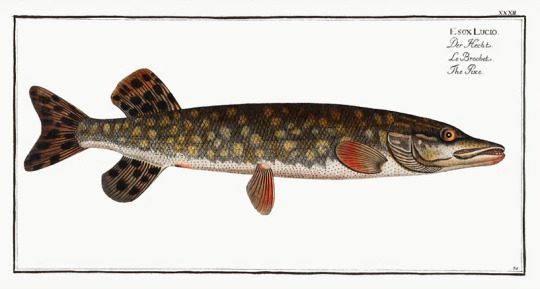
We were both working blue collar jobs and not making a lot, but also putting a teenager (my cousin) through school, including JROTC and FFA . Money was tight and we didn't have a lot extra to go out and do your typical fun things like movies or eating out. What we ended up doing in most of our free time was riding dirt roads on our way home from work. Ths evolved into stopping at every creek along the way to see if we could catch fish. You wouldn't catch us without fishing poles in the vehicle that summer!
And there we discovered one of our favorite things to do. Even now, eight years later and a lot better off you can still catch us creek fishing multiple times a year, especially in the summer. Fishing was fairly cheap for us to do and it was always so much fun because you never knew what you would catch. And finding new fishing spots was a challenge when we had the extra gas to ride around.
Several weeks into our fishing adventures I was talking to a coworker about some of our fishing experiences and he asked me if we had caught any Redfin Pike. I had never heard of such a fish so I was intrigued and asked him what it was and why they were special. According to him, Redfin Pike is a special kind of creek fish that is really hard to catch. They are elusive and don't bite just anything that drops into the water, they are also big fighters when you hook them despite being a small fish. They only get about 12 inches long. According to my coworker and other old timers I have spoken to apparently they are quite good to eat, talked about as a "chicken of the creek". He talked about them like they were almost a mythical fish. A unicorn, so to speak.
Part of what makes them hard to find is that they only thrive in running water, so many of the streams and creeks they used to flourish in have dried up or have been redirected to the point that they don't flow enough to be a suitable habitat for Redfin Pike.
My coworker also told me that they were bloodthirsty fish and that to catch them you would want to use a lure or other bait with red on it to resemble an open wound.
That was all it took, we were on a mission. A mission to find a unicorn. I mean, a Redfin Pike.
Armed with our favorite fishing gear and some new things we splurged on for this special fish, we headed out to some of our favorite spots. It took us a few weeks but eventually we did find a good fishing hole that was, if not teeming, then definitly well stocked with Redfn Pike.
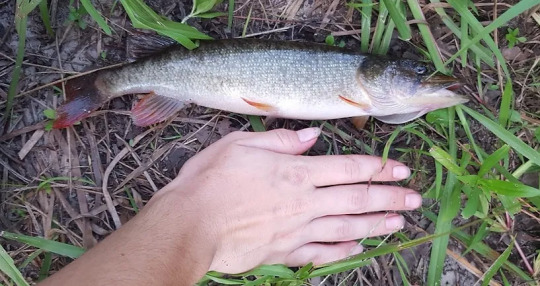
What surprised us though is that we did not catch the first ones off anything red as we had been hearing that Pike loved. We caught the first ones on a blue crappie grub while we were trying to catch Warmouths at a creek that ran through a friend's property. We were so surprised that it took us a minute to realize that we had finally caught a Redfin Pike!
They were everything we had been told and so much fun to catch. We went to that same fishing spot several days later and were able to catch a few more on a lure that is a favorite of my husband's, he has caught everything from Largemouth Bass to tiny Breem, and yes, Redfin Pike.
Picture below of my husband, so proud of catching a fish we had spent weeks trying to find, and our biggest catch to date.


To this day we haven't eaten one of these so I can't speak for the taste but they are every bit as fun to catch as they are reputed to be. If you ever have the opportunity to fish in a creek in Georgia, be sure to keep an eye out for our elusive friend the Redfin Pike.
If you liked this post please visit my blog. The clicks really do help my self esteem :)
#fish#fishing#redfin pike#creek fishing#rural america#rural life#georgia#rural georgia#georgia girl#country girl#fishing life#slow living#country living#mepps lures#redneck things
2 notes
·
View notes
Text
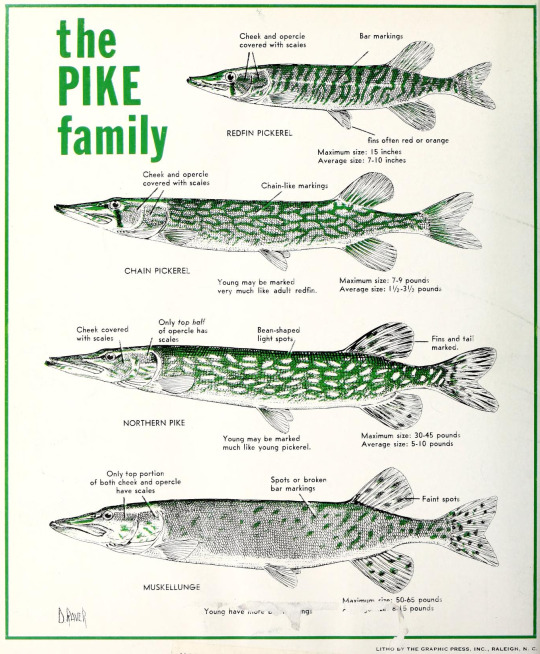
Wildlife in North Carolina. February 1965. Illustration by Duane Raver Jr.
Internet Archive
#marine life#fish#bony fish#pickerel#redfin pickerel#chain pickerel#pike#northern pike#muskellunge#Duane Raver Jr.
921 notes
·
View notes
Text
Rating lures based on the accuracy to the species they protray:

Okay so I've posted a few posts now on some disappointing lures so I wanted to do the cool ones this time. These would be Orangspotted Sunfish which a) are my fave centrarchids, and b) are a cool fish overall. The body coloration reflects non-breeding colors which is certainly less vibrant, but pretty accurate overall. This is a fun guy I'd love to have as a pet. 9/10.

Pikes are so rare as lures I wanted to include them. The shape? Chef's kiss. The packaging gives the tail a weird kind of shape but we shouldn't judge one based on the conditions in which they are forced to live. The colors I'm less wild on. The patterning says Northern Pike but the specific colors seem to suggest Redfin Pickerel. Are you a hybrid, little dude? Let's say 7/10.
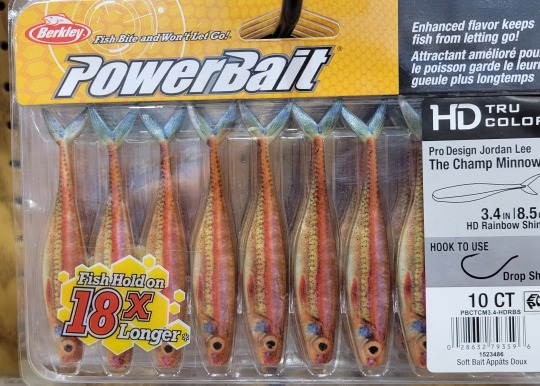
These fellas are Notropis spp. shiners, likely Rainbow Shiners (N. chrosomus). From the body color to the blue gill plates, these are pretty spot on. Most Rainbows have a dark horizontal stripe along the lateral line where these have pale, but you can find both patterns in this species. 10/10 I love them.

What a pretty guy! Labeled as a Bluegill, this lure is an inch or so long; with that in mind, these are adult colors, not juvenile colors. The white in there is also not accurate. But I like him! He gets an 8/10 from me.

You know, though Yellow Perch lures are a dime a dozen, I think these are pretty close to the mark. The colors (especially the orange) is a little neon-y and the head is an odd white color, but I think they have a nice mix of realistic and eye catching. 7/10
74 notes
·
View notes
Video
youtube
Are you a catch and release fisherman? Here is a video which I have made, giving a few tips to ensure your catch swims off fine.
#fishing#trout#cod#browntrout#murraycod#crappie#pike#carp#redfin#perch#yellow perch#salmon#catch and release
7 notes
·
View notes
Text
in case you where wondering what this weird fishenthusiast has been doing:
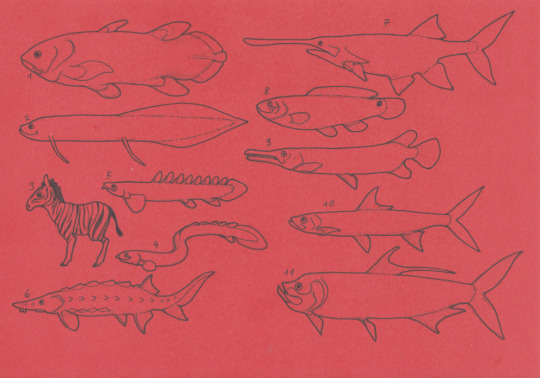



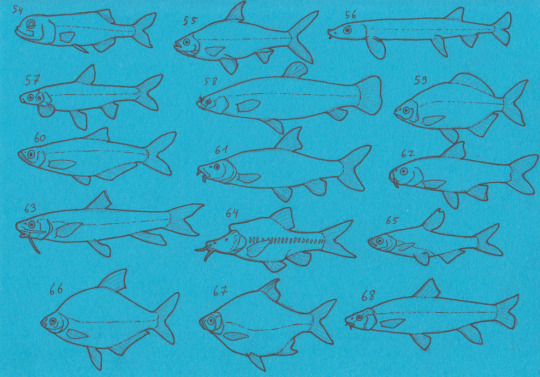
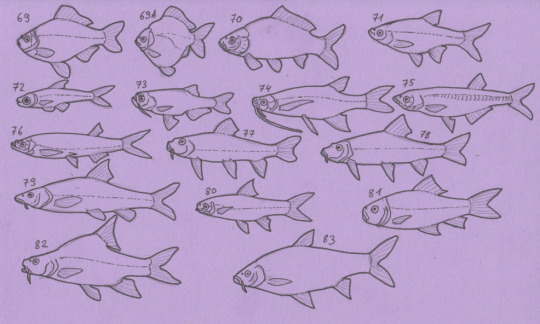
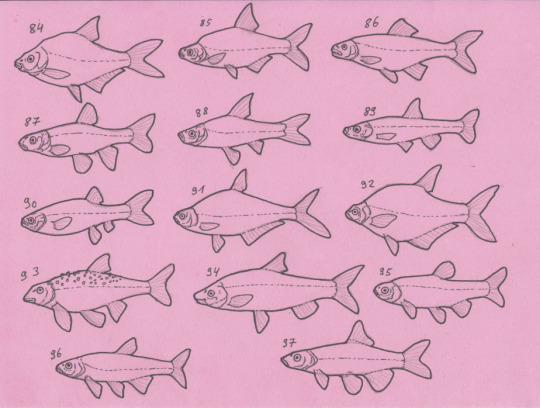
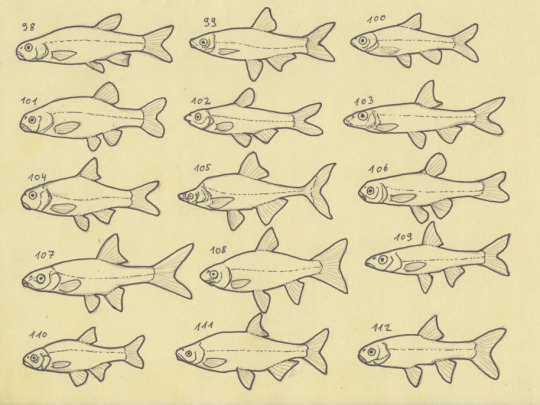
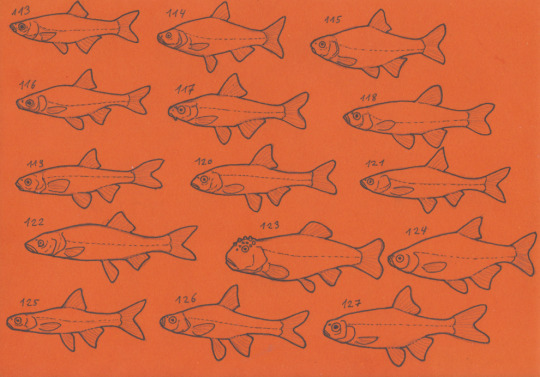
1 Coelacanth 2 Lungfish 3 Tetrapod 4 Ropefish 5 Bichir 6 Sturgeon 7 Paddlefish 8 Bowfish 9 Gar (messed up Maxillary needs correction) 10 Ladyfish 11 Tarpon 12 Japanese gissu 13 bonefish 14 deep sea spiny eel 15 Halosaur 16 Protanguilla 17 cutthroat eel 18 Mud eel 19 thin eel 20 moray eel 21 false moray (u r a FRAUD!) 22 longneck eel 23 snake eel 24 pike conger 25 duckbill eel 26 conger 27 garden eel 28 Bathymyrinae 29 spaghetti eel 30 pelican eel 31 Saccopharynx 32 onejaw gulpers 33 bobtail snipe-eel 34 freshwater eel 35 snipe eel 36 sawtooth eel 37 Mooneye 38 freshwater butterflyfish 39 arowana 40 knifefish 41 aba 42 freshwater elephantfish 43 anchovi 44 denticle herring 45 Pellona 46 Pristigaster 47 wolf herring 48 round herring 49 herring 50 sardine 51 sprat 52 menhaden 53 sprat 54 Slickhead 55 milkfish 56 beaked salmon 57 shellear 58 hingemouth 59 bitterling 60 bleak 61 barbel 62 redfin 63 snowtrout 64 Golden-Line fish 65 sharpbelly 66 white amur bream 67 tinfoil barb 68 khramulyas 69 crucian carp 69A ryukin goldfish 70 common carp 71 carplet 72 rasbora 73 danio 74 flying barb 75 silver cyprinid 76 razorbelly minnow 77 false gudgeons 78 gudgeon 79 steed 80 mud carp 81 labeo 82 yellowfish 83 Leptobarbus 84 common bream 85 bleak 86 chiselmouth 87 longfin dace 88 mexican chub 89 spanish minnowcarp 90 aztec chub 91 bream 92 silver bream 93 stoneroller 94 nase 95 dace 96 redside dace 97 ornate shiner 98 lake chub 99 satinfin shiner 100 desert minnow 101 desert dace 102 longjaw minnow 103 slender chub 104 cutlips minnow 105 western chub 106 flame chub 107 california (roll ) roach 108 silvery minnow 109 bigeye chub 110 least chub 111 hitch 112 spinedace 113 moderlieschen 114 eurasian dace 115 highscale shiner 116 finescale shiner 117 blacktail chub 118 pearl dace 119 spikedace 120 moapa dace 121 peamouth 122 hardhead 123 hornhead chub 124 golden shiner 125 eastern shiner 126 pugnose minnow 127 oregon chub
And I am NOWHERE NEAR finished!
2K notes
·
View notes
Text
Red Dead Redemption 2: Fishing Guide
The post Red Dead Redemption 2: Fishing Guide appeared first on Fextralife.
Rockstar’s Red Dead Redemption 2 Western set action-adventure RPG title has a large compendium. The compendium in Red Dead Redemption 2 allows players to track Animals, Cigarette Cards, Equipment, Fish, Gangs, Horses, Plants, and Weapons. In this Fishing Guide, I’ll give you tips and locations to quickly complete the fish section of the compendium.
Red Dead Redemption 2: Fishing Guide
Below you will find a list of fish according to their name, location as well as useful information including lure type needed, and helpful tips to get your catch of the day.
Fish
Location
Lure/extra tips
Normal Fish
Bluegill
Chain Pickerel
Can be found in most bodies of water.
Can be found North East of Brandywine Drop
Use Corn as bait.
Redfin Pickerel
Can be found in the Kamassa River to the East of Maclean’s House. Fish at night to avoid the owners being aggressive or just hogtie them before fishing.
Use bread as bait.
Rock Bass
Can be found to the West of Fort Brennand in the Kamassa River.
Use bread or cheese bait. (I like using bread)
Smallmouth Bass
Can be found in the body of water South of Clemen’s Point.
Use Crickets as bait.
Bullhead Catfish
In the town of Lagras, head to the Western part near the shore and fish off the coastline.
Use corn as bait.
Perch
Can be found in the Kamassa River West of Beaver Hollow.
Use bread as a bait.
Lake Sturgeon
Located in Lagras Lake of the Lakay peninsula.
Use Swamp Lure
Largemouth Bass
Can be found in the body of water West of Clemen’s Point.
Use Crayfish as bait.
Steelhead Trout
Can be found in the Kamassa River South of the “E” in Kamassa River.
Use worms as bait.
Channel Catfish
Can be found in the Swamp region body of water
Can be found by fishing from both shores near the “SS” in Kamassa River.
Use Swamp Lure
Longnose Gar
Can be found in any swamp region’s body of water.
Use Swamp Lure
Muskie
Located near lighthouse in Van Horn Trading Post. Fish at the east side of it to find Muskie.
Use River Lure.
Northern Pike
Found in the Kamassa River South West of the Roanoke Valley.
Use River Lure
Sockeye Salmon
Found in the Kamassa River North of Fort Brennand but South of the Railway that crosses the river.
Use River Lures
Legendary Fish
Legendary Bluegill
Located at the Flat Iron Lake, between the shore and and small island south of Clemens Point.
Use Special Lake Lure.
Legendary Chain Pickerel
Located northwest of Flatneck Station, in Dakota River.
Use Special River Lure.
Legendary Bullhead Catfish
Located on Sisika Island, to the west of penitentiary.
Use Special River Lure.
Legendary Redfin Pickerel
Located in Stillwater Creek to the east of MacFarlane’s Ranch.
Use Special Lake Lure.
Legendary Rock Bass
Located in Aurora Basin north of Lower Montana River.
Use Special Lake Lure.
Legendary Smallmouth Bass
Located in Owanjila Lake to the west of Strawberry.
Use Special Lake Lure. (I like casting off from the East coast of the lake near the portrait of fish’s mouth)
Legendary Perch
Located in Elysian Pool in southwest Annesburg.
Use Special Lake Lure.
Legendary Lake Sturgeon
Located below the southern railroad bridge leading to Saint Denis. Stand on the edge of the bridge to avoid being hit by trains.
Use Special River Lure.
Legendary Largemouth Bass
Legendary Steelhead Trout
Located next to the waterfall north of Annesburg, northeast part of the world map. Near Willard’s Rest point of interest.
Use Special River Lure.
Legendary Longnose Gar
Located in Lagras Lake. Head to northwest tip of Lakay peninsula and fish there.
Use Special Swamp Lure.
This is the only legendary fish that requires Special Swamp Lure, you can use any other special lure and save $20, but it will be harder to catch it.
Legendary Muskie
Located near lighthouse in Van Horn Trading Post. Fish at the east side of it to find Muskie.
Use Special River Lure for Legendary Muskie.
Legendary Sockeye Salmon
Found in Lake Isabella.
Use Special Lake Lure.
Red Dead Redemption 2 launched on Playstation 4 and Xbox One on October 26th.
Be sure to check out more Red Dead Redemption 2 in Red Dead Redemption 2 Update 1.04 and Red Dead Redemption 2 Online: Exclusive Item Locations. You can also get all your outlaw needs with our Red Dead Redemption 2 wiki.
The post Red Dead Redemption 2: Fishing Guide appeared first on Fextralife.
Red Dead Redemption 2: Fishing Guide published first on https://juanaframi.tumblr.com/
0 notes
Photo

Ontario Species at Risk for December 3, 2017
Grass Pickerel. (Esox americanus vermiculatus)
SPECIAL CONCERN Like other members of the pike family, the Grass Pickerel has a long, cylindrical body with a long snout and forked tail. The dorsal and anal fins are located well back on the body, enabling sudden high-speed bursts which it uses to help capture prey.
Grass Pickerel are threatened by activities that may result in decreased water levels, loss of aquatic vegetation, and decreased water clarity. Specific activities that threaten the species include realignment or alteration of agricultural drains, nutrient enrichment through wide-spread application of fertilizers, manure spills and sewage treatment outputs, shoreline modifications and alteration of natural flow regimes.
The Grass Pickerel is widely recognized as a subspecies of the Redfin Pickerel, however recent research suggests that it may be a distinct species.
https://www.ontario.ca/page/grass-pickerel
0 notes
Text
Pickerel - The Water Wolf
Chain Pickerel are very common in most waters that contain panfish on the eastern seaboard. They go by a few different names depending on where you find them. They may be called jacks, jackfish, gun fish, federation pike or southern pike if they don’t go by their proper name in your area. Found from Canada to Florida and west to the Mississippi drainage, chances are they are swimming in your favorite panfish hole. Pickerel are often an accidental catch by anglers pursuing other species, many people like myself target them specifically. Pickerel are great sport on a fly rod. They take a variety of flies including topwater patterns. They often strike flies viscously, are powerful fighters on light tackle and often take to the air.
Pickerel are not as popular with anglers as their larger cousins the northern pike and muskellunge. Many anglers have a strong disdain for these fish, which is something I have never been able to understand. I often hear the complaint that they prey on more popular game fish and they mistakenly think that by eliminating them they will improve the fishery for their preferred species. Nothing could be further from the truth. Our warm water ecosystems need a balance of prey and forage species and pickerel fill an important role as a predator. This spring, in particular, I have come across some pickerel heartlessly thrown up on the bank to die. What a waste of a great game fish!
These toothy scrapers can live up to eight years and grow up to 30” long. The world record was a 9lb 6oz giant caught in Georgia in 1961. Here in my home state of New Jersey, the record is 9lb 3oz, so we grow them pretty big up here as well. I’m certain that some waters in my home state have the potential to produce the next world record, though both records are over 50 years old so maybe the days of these giant pickerel have passed us by.
In addition to the chain pickerel, there are also two smaller species the grass and the redfin pickerel. Because of their diminutive size, they are not often sought by anglers. Redfin pickerel are common in my area with the state record be caught less than 5 minutes from my home. They can be found in the same waters as their chain sided cousins.
All species of pickerel are ambush predators that rely heavily on sight to catch their prey. They will lie motionless in cover then explode violently to secure their meal. They are lightning fast when they need to be but can also be incredibly stealthy sometimes rising like a submarine behind a fly to give it a closer look. Because they are ambush predators, they will always be found near cover. Aquatic vegetation is their preferred cover, but if it lacks in their habitat, they will also orient themselves to other structure types like wood or stone. When it comes to pickerel, the thicker the vegetation, the better. They will lie concealed then burst from cover to take their prey or your fly! They can be found in water depths only inches deep along the shoreline to submerged weed beds in 20-30 feet of water.
Chain pickerel feed on a wide variety of organisms including fish, frogs, mice, crayfish even birds. I once saw a healthy specimen leap from the water and take a redwing black bird that was hanging on a reed inches above the water. Juvenile fish will feed on aquatic and terrestrial insects as well. If they can fit it into their large, tooth filled mouth, they will try and eat it. Like other members of the pike family, their appetites sometimes exceed their abilities. On more than one occasion I have come across a dead pickerel that attempted to swallow a fish almost as large as itself!
Because of their expansive appetite chances are you have flies that will be attractive to them. Streamers, especially ones with a bit of flash in them are irresistible to pickerel. But more subdued offerings like a standard black or olive Woolley bugger have taken countless numbers of these fish. One of my favorite warm water patterns, the James Wood Bucktail is particularly attractive to these fish. Topwater flies are probably my favorite ways to target pickerel. All of your standard and not so standard bass bugs, frogs and mice patterns will work. A weedless fly is almost a necessity because of where these fish like to hang out. On one of my local lakes, a large dragonfly pattern cast to the edges and in pockets of lily pad fields will take pickerel all summer long. You will often see these fish jumping clear out of the water to take air borne insects.
Although I often hook these fish while fishing for panfish on two and three weight rods, If I am specifically targeting them I prefer a rod in the 5 or 6 wt range. A heavier rod makes it much easier to cast the larger more wind resistant flies that are attractive to pickerel. Some folks use a wire tippet to eliminate bite offs, but I usually fish with a short bite guard of heavy mono. I may lose a fish now and then, but I think I get far more hooks ups. Pickerel have excellent eye sight, and that wire leader may be a put-off.
I prefer to use barbless hooks when fishing for pickerel. Once again, I may lose a fish now and then, but pickerel tend to take flies very deeply. They also have a mouth full of razor sharp teeth. Besides being easier on the fish, it is also easier on me. One more than one occasion I have found my fingers engaged with the business end of this fish, and the result is always bloody! A fish grip tool that grabs the fish by the jaw is a handy item to have on hand when dealing with these toothy critters. I keep such a device permanently attached to my kayak for dealing with chance encounters with these toothy predators.
If you are looking for an exceptional meal, pickerel are excellent table fare, though they are a little tricky to clean to ensure a boneless fillet. Pickerel have a set of Y-bones that run down their sides that will result in a mouth full of bones if you fillet them in the usual fashion. The method I use results in five boneless fillets. Click this link, if you are interested in learning more about this method of filleting.
If you have not chased pickerel with a fly rod you're missing out on a lot of fun; their explosive topwater takes will get your adrenaline flowing. They are acrobatic hard fighting fish that will have you begging for more. Give chain pickerel a try, all I ask is that you treat them with the respect they deserve.
0 notes